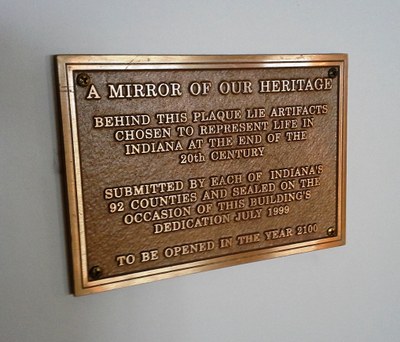
Purchase Tickets
Tapping into Time Capsules
March 3, 2015

It seems that time capsules never really leave the news these days. Both nationally and closer to home, people are discovering, opening and placing time capsules in a constant cycle of anticipation, excitement and occasionally disappointment. Many a news story tells the tale of a wet or decayed mass of papers removed from a time capsule that leaked, stealing away the fun of learning what our ancestors left for us to discover. Recent time capsule stories from Boston, however, illustrate the wonder and satisfaction that a community can share when objects from the 1790s are carefully removed by conservators and found to be in a remarkable state of preservation. In the case of the Boston time capsule, the group that originally deposited the items under the cornerstone of the Massachusetts State House included famed Revolutionary War patriot Paul Revere.
The Massachusetts State House example is also a good way to learn more about time capsule terminology. Technically speaking, a time capsule is placed with an end date when it will be opened. Time capsule specialists prefer the use of “foundation deposit” when objects are placed with no set date for the materials to be rediscovered. Informally, however, many people use the term “time capsule” to cover both circumstances.
Closer to home, and our own century, we find time capsules everywhere. Hoosiers are no less resistant to the time capsule bug than people in Boston. In late 2014, a road construction project in Richmond, Indiana, revealed a time capsule inside a monument marking the location of Civil War-era Camp Wayne and dedicated by the Sons of Union Veterans in 1926. Current members of the Sons of Union Veterans of the Civil War later gathered at the Wayne County Historical Museum to open the time capsule and reveal its contents. The discovery of a roster of the organization’s officers and a newspaper from the day of the time capsule’s sealing reminded everyone present that many Civil War veterans were still alive and attended the dedication ceremony in 1926. The act of opening the time capsule and the plan to re-seal it when the monument is restored created an instant connection between the past and the present in a way that only meaningful objects can.
Here at the Eugene and Marilyn Glick Indiana History Center, we have our very own time capsule sealed in July 1999 and set for reopening in the year 2100. County historians were invited to ask their communities what they would like to add to the IHS time capsule as a way to represent their county in the future. A small, acid-free box from each of the state’s 92 counties now resides in a place of honor in the building, safe from the effects of the weather and possible water leaks.
So, if you would like to try a time capsule project in your own town or county, ask your community what they would like to have included, and make it a fun event for everyone. Even better, coordinate your time capsule event with the Indiana Bicentennial celebration – visit the Indiana Bicentennial Commission’s website to learn how to have your event officially endorsed as a Bicentennial Legacy Project. And, when you visit us here at the History Center, see if you can find the plaque the marks the location of our time capsule!









